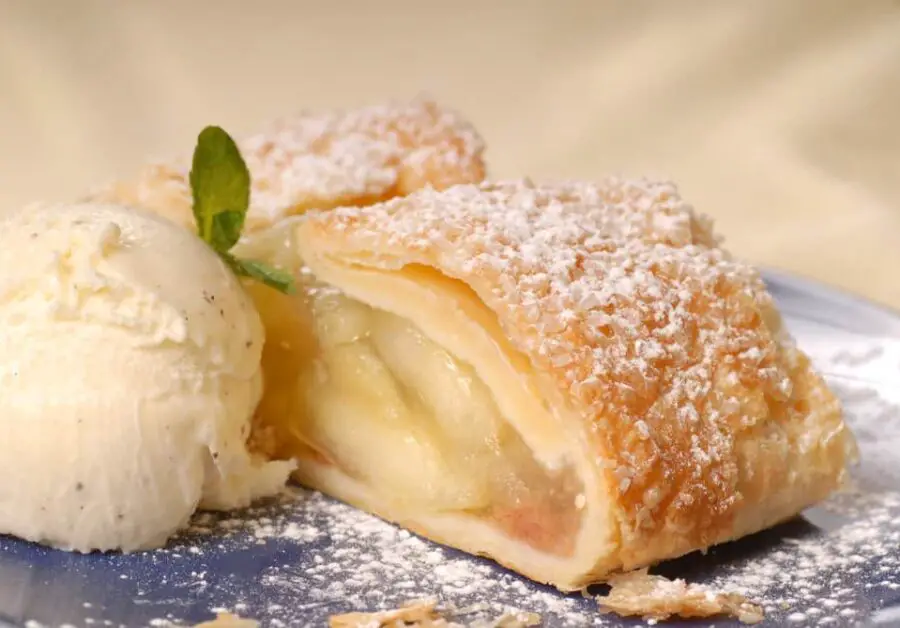For anyone who’s a lover of the scrumptious world of Austrian and German baked treats, then you definitely won’t want to sit down and read this article with an appetite!
Why?
Because we’re going to be talking about two of the world’s most treasured treats – streusel and strudel!
More specifically, we’ll be covering what makes each of them unique because, in fact, they differ greatly from one another.
Much of the confusion surrounding this lies in the similar sounding names, but the truth is that these delectable goodies have little in common.
That said, the main difference between streusel and strudel is that streusel is a crumbly topping which is baked on things like cakes and pies, whereas strudel is a type of layered sweet or savory pastry.
Of course, this is the obvious difference, but there are many more, including how they came to be, the ingredients used and how each of them are prepared.
So, if you’re ready, try to keep your cravings under control long enough to learn all about them!
Historical Differences
Today, crumb toppings are used for many kinds of desserts, from coffee cake to cobblers. However, the origins of this delectable sweet treat have their origins with a cake that featured a topping known as streuselkuchen.
The term, which is German, literally translates to mean “crumb cake” and although it’s often associated with the same country, it’s thought that crumb cake originated in another European country, Poland and more specifically, in a historical region known as Silesia.
At the time, Silesia was located primarily in Poland, but also extended to parts of Germany and the Czech Republic. Although the exact details of how it came to be aren’t precisely clear, what is known is that the region of Silesia where crumb cake became popular was what’s today part of Germany.
However, the recipe came to be passed on through the generations. Now, crumb cake is widely recognized as a German dessert in most of the world.
Streuselkuchen itself is traditionally flat cake that is cut into rectangular pieces. The crumb mixture is added about a 1:1 ratio, meaning that there’s an equal height of crumb to cake.
Over time, bakers experimented with the tasty streusel topping by adding new flavors and spices to it and today, it’s plain to see how far and wide this beloved topping has spread.
Although streusel and strudel have similar sounding names, the origin of strudel is different. It’s not Germany that can lay claim to the creation of this wonderful dessert, but rather Austria.
However, to add to the confusion, the word “strudel” is German in origin, specifically Middle High German. The word is translated to mean “whirlpool” which is an accurate description of the swirling pattern you see in the finished dough of a fresh-baked, flaky strudel.
It’s thought that the earliest version of it, a recipe for a milk strudel, known as millirahmstrudel, dates to the end of the 17th century. In Vienna, there’s a handwritten recipe for it which is kept safely at the City Hall library.
From there, the popularity of strudel continued to grow over the next century and spread through the predecessor of modern day Austria, the Habsburg Empire.
| Dessert | Origin | Traditional Shape | Ratio of Topping to Cake |
|---|---|---|---|
| Crumb Toppings | Silesia (Poland) | Various | 1:1 |
| Streuselkuchen | Silesia (Germany) | Rectangular | 1:1 |
| Strudel | Austria | Swirled | N/A |
Ingredient and Preparation Differences
Given that streusel and strudel are so different from each other, it probably should come as no surprise that the ingredients required and methods used to prepare them would also be unique.
Of the two, streusel is the easier to prepare and often contains a very simple list of ingredients including butter, sugar, and flour.
The simplest method is to combine all dry ingredients into a mixing bowl. From there, butter is added and incorporated into the mixture through a process known as “cutting in butter“. This can even be done by hand and once the mix appears “crumbly”, it’s ready to be added to cakes, pies, or anything else that needs a delicious topping!
Although most associate strudel with being sweet, the dough itself normally isn’t. Most often it contains flour, water, oil and salt, but that’s not the only thing that separates it from things like puff pastry.
What makes this dough unique is how thin it must be to make the perfect strudel. Ideally, the dough is considered ideal when it’s reached a paper thin consistency. To achieve this involves a lengthy process of working the rough, letting it rest, rolling it out and then stretching it by hand.
Once the dough is stretched, it should be the shape of a rectangle and if you’ve done a good job, perhaps even thin enough to see through. From here, filling is added to one half of the dough while the other half is usually brushed with butter.
Next, the sides of the dough are folded over the filling before rolling the entire mix and popping it into the oven.
| Dessert | Ingredients | Preparation Method | Difficulty Level |
|---|---|---|---|
| Streusel | Butter, sugar, flour | Mix dry ingredients, “cut in” butter, ready to use | Easy |
| Strudel | Flour, water, oil, salt | Mix ingredients, roll out and stretch dough, add filling, roll and bake | Medium-Difficult |

Hiya! I’m Kimberly, a contributing writer here at Miss Buttercup. I was born and raised in the UP, Michigan’s Upper Peninsula for those who don’t know, the land of beautiful, beach-filled sunny summer days and bone-chilling long winters. Growing up there made me appreciate all the little things about life, especially the way a delicious meal can bring people closer together. I try and put that same feeling into each article I write and I hope it comes across that way!

